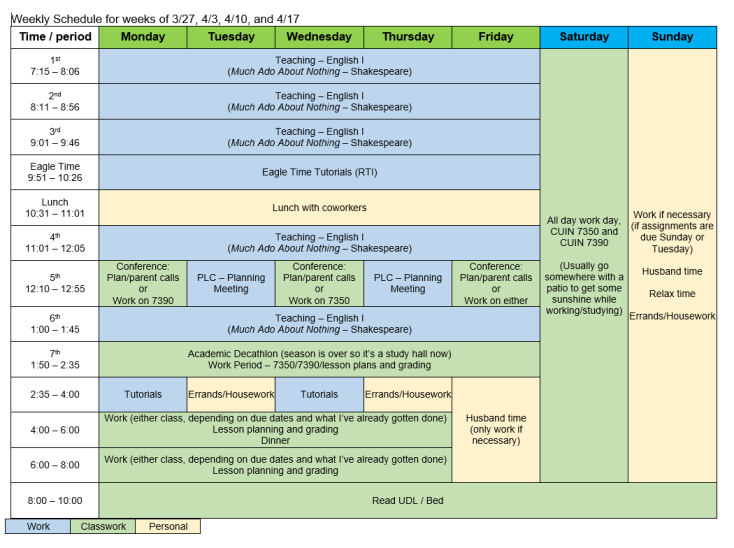There’s something exhilarating, and somehow relaxing at the same time, about sitting at the keyboard with a blank blog post open in front of me, something silly in place of a final title, words slowly making their way across the blankness to form a new post. I have missed this.
So, why haven’t I been here the last couple of weeks?
I have been feeling the end of the school year drag hardcore since April 1st. The day my classroom countdown hit 60 days – just 2 more months until summer – my internal motivation and energy crashed harder than the stock market after Brexit. Of course, two months is far from being finished, and still left me one whole month of my graduate classes to complete. No matter how tired I am, there’s no giving up just yet.
This month, my Integrating Technology class has been participating in another ISTE (International Society of Technology in Education) book study. This time the book is UDL in the Cloud! by Katie Novak and Tom Thibodeau. For those who don’t know, UDL stands for Universal Design for Learning. Simply put, UDL focuses on removing barriers from learning so that ALL students, regardless of disabilities, language abilities, or learning style can learn. There is much more to it than that, but for the sake of this particular post, we’ll keep it simple. This book specifically discusses how to remove those barriers in online instruction. Time management is one of those barriers.
I’ve honestly always viewed time management as something you just have to figure out on your own, not something that any content teacher must teach. After studying this book, I’m beginning to change my view.
One of the activities asked us to create a schedule showing how we would manage the time required to participate in the book study. This was the most depressing assignment I have ever completed; although, it did answer the question, “Why am I always so tired?”
I manage my time mostly without thinking about a schedule. I know what needs to be done and when it needs to be done and I get it done. My time management style is generally just a lot of to-do lists. (And yes, I put silly things on my list so I can feel the satisfaction of checking “eat dinner” off the list.) So, completing this activity was more of a reflection and visualization of how I spend my time than actually deciding how to spend it.
Take a look:

That is just not enough yellow. And where is nap time?! There are days that it looks like the only time I could be social, or simply not work, was during my 30-minute lunch. Just looking at this schedule makes me exhausted. It’s no wonder “blog writing” didn’t find its way in anywhere.
Ok, let’s be realistic for a minute. We all know that this is not a 100% true representation of my life. That whole 4pm to 8pm period might be set aside for getting work done, but that doesn’t mean I’m not also watching television with my husband and scrolling Facebook at the same time. Like I said, my method of managing time is a series of to-do lists. I know what needs done and I do it. This very often means that I do actually end up getting to do fun things during times that are blocked off for work if I’ve gotten my work done. Or even if I haven’t, but I know when I will get it done. For instance, just two weeks ago, my husband and I went to the Houston Art Car Parade and spent a day getting sunburned in Galveston.
The point of time management isn’t to spend all of your time working, but to be aware of your time. I wouldn’t have gone to Galveston for the day if I still had a to-do list a mile long. It’s about being smart and, more importantly, being responsible. Creating a schedule is a great way to make sure procrastination doesn’t beat out getting work done. And this is a skill that is necessary for school life, work life, personal life, family life, all parts of life.
So, to get back to my point, I’ve learned through this book study that maybe it’s not necessarily the explicit job of teachers to teach time management, maybe it’s not one of the extensive standards we have to teach, but it certainly helps reduce barriers if students are given some basic time management skills.
Every school year, I start the first week with my expectations and classroom procedures. This is usually more than just going over the classroom rules; it usually includes practicing how to walk into my classroom or put supplies away. This year, I think I’ll add a time management component. Students can create their own weekly schedule of how they expect to spend their time now that they’re in high school, including time for after school tutorials and homework. I can show them my schedule as a scary example of adulthood, especially since next year will include three graduate classes, one of which will be face-to-face every Wednesday night.
Maybe it’s not one of my standards, but if I want my students to learn to manage their time, learn to be responsible, learn to learn, then it’s my responsibility to teach them.
On the bright side, if anyone ever asks why I don’t workout anymore, I can just show them this schedule and tell them to go away while I eat my pork rinds and do my homework.